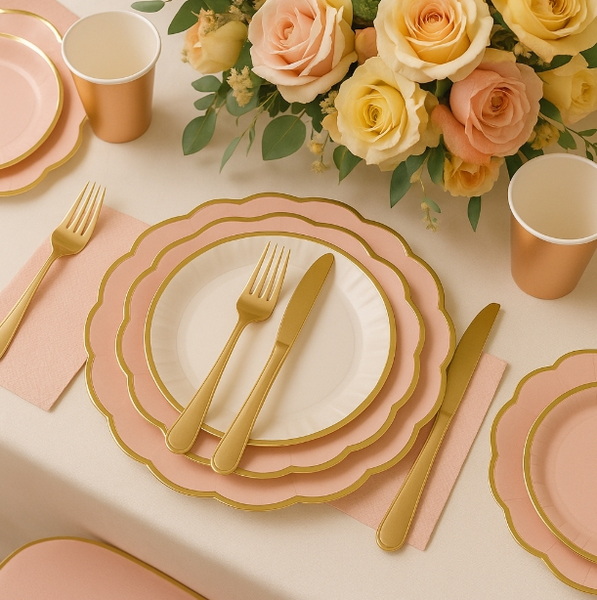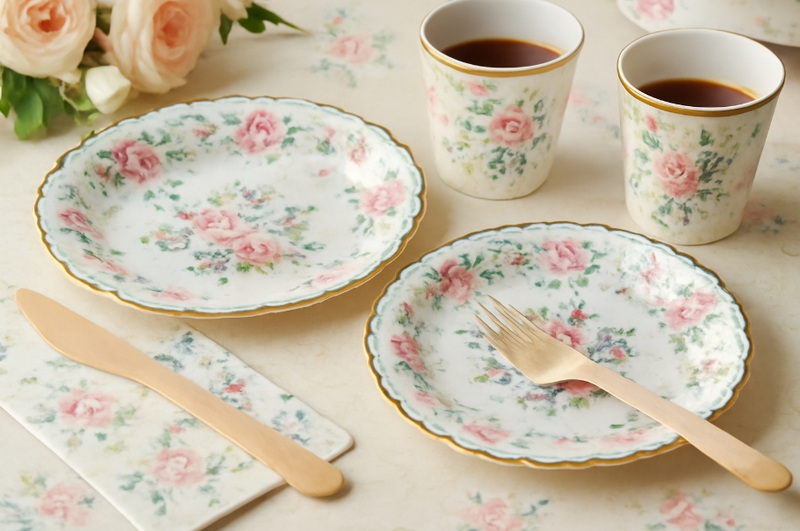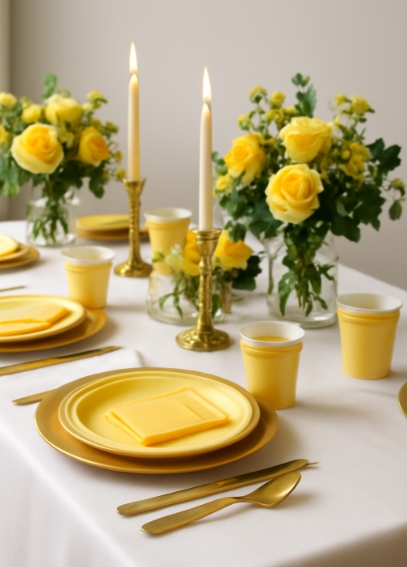
Content Menu
● Understanding Disposable Wedding Plate Sets
● Types of Disposable Wedding Plates
● The Environmental Impact of Disposable Plates
>> Plastic Plates
>> Paper Plates
>> Biodegradable Plates
● Benefits of Using Disposable Wedding Plate Sets
● Drawbacks of Disposable Wedding Plate Sets
● Sustainable Alternatives to Disposable Plates
● Materials Used in Disposable Wedding Plate Sets
>> Plastic
>> Paper
>> Bamboo
>> Palm Leaves
>> Sugarcane Bagasse
● Aesthetic Appeal of Disposable Wedding Plate Sets
● Cost Analysis: Disposable vs. Reusable
>> Disposable Dinnerware Costs
>> Reusable Dinnerware Costs
● Conclusion
● FAQ
>> 1. Are all disposable wedding plates harmful to the environment?
>> 2. How do I ensure my disposable plates are eco-friendly?
>> 3. Can I recycle plastic disposable plates?
>> 4. What is the best material for eco-friendly disposable plates?
>> 5. How many disposable plates should I order for my wedding?
● Citations:
Planning a wedding is a monumental task that involves numerous decisions, from the venue to the flowers, and even the dinnerware. One of the increasingly popular choices for modern weddings is disposable wedding plate sets. While they offer convenience and cost-effectiveness, many couples are left wondering about their environmental impact. This article delves into whether disposable wedding plate sets are eco-friendly and sustainable, exploring various materials, benefits, drawbacks, and alternatives.

Understanding Disposable Wedding Plate Sets
Disposable wedding plate sets are designed for single-use during events like weddings. They come in various materials, including plastic, paper, and biodegradable options. The rise in popularity of these plates can be attributed to several factors:
- Cost-Effectiveness: Disposable plates are generally cheaper than renting or purchasing traditional china.
- Convenience: They eliminate the need for washing dishes post-event, allowing couples to enjoy their special day without worrying about cleanup.
- Variety: Available in numerous styles and designs, disposable plates can match any wedding theme.
Types of Disposable Wedding Plates
When considering disposable wedding plate sets, it's essential to understand the different types available:
- Plastic Plates: Often seen as a standard choice, these plates are lightweight and durable but pose significant environmental concerns due to their long decomposition time.
- Paper Plates: Generally more eco-friendly than plastic, paper plates can still have environmental impacts depending on their production processes.
- Biodegradable Plates: Made from materials like sugarcane bagasse, palm leaves, or bamboo, these plates break down more quickly and are often compostable.
| Type of Plate | Material | Environmental Impact |
| Plastic | Polystyrene | Takes hundreds of years to decompose |
| Paper | Wood pulp | Can be eco-friendly if uncoated |
| Biodegradable | Sugarcane/Bamboo | Breaks down in months; compostable |
The Environmental Impact of Disposable Plates
The environmental impact of disposable wedding plate sets varies significantly based on the material used:
Plastic Plates
Plastic plates are often criticized for their long-lasting presence in landfills. They can take hundreds of years to decompose and contribute to pollution in oceans and other ecosystems. Marine life often ingests plastic waste, leading to health issues for wildlife and potentially entering the human food chain.
Paper Plates
While paper plates are generally seen as a better option than plastic, they still have environmental concerns. The production of paper requires cutting down trees and consumes large quantities of water and energy. Additionally, many paper plates are treated with chemicals that can hinder their compostability.
Biodegradable Plates
Biodegradable options made from materials like sugarcane or palm leaves offer a more sustainable choice. These plates can decompose within months when disposed of properly in compost facilities. However, it's important to note that not all biodegradable plates are created equal; some may still contain harmful chemicals that prevent them from breaking down effectively.
Benefits of Using Disposable Wedding Plate Sets
Choosing disposable wedding plate sets comes with several advantages:
- Cost Savings: Renting china can be expensive; disposable options provide a budget-friendly alternative without sacrificing style.
- Time Efficiency: With disposable plates, couples can focus on enjoying their day rather than worrying about washing dishes afterward.
- Hygiene: Single-use plates reduce the risk of cross-contamination between guests, which has become increasingly important in light of health concerns.

Drawbacks of Disposable Wedding Plate Sets
Despite their benefits, there are notable drawbacks associated with disposable wedding plate sets:
- Environmental Concerns: As discussed earlier, plastic options pose significant environmental threats. Even some paper plates can have a negative impact if not sourced sustainably.
- Quality Issues: Some disposable plates may not hold up well under heavy foods or liquids, leading to spills or leaks during the event.
- Limited Reusability: While some biodegradable options can be rinsed and reused once or twice, most disposable plates are designed for single use only.
Sustainable Alternatives to Disposable Plates
For couples looking to minimize their environmental footprint while still enjoying the convenience of disposable dinnerware, consider these alternatives:
- Renting Reusable Dinnerware: Renting china or glassware can be an eco-friendly option that allows for elegant table settings without the waste associated with disposables.
- Compostable Dinnerware: Opt for high-quality compostable plates made from natural materials like bamboo or bagasse that break down after use.
- DIY Solutions: For those crafty couples, creating unique table settings using vintage or thrifted dishware can add a personal touch while being environmentally conscious.
Materials Used in Disposable Wedding Plate Sets
Understanding the materials used in disposable wedding plate sets is crucial for making informed decisions regarding sustainability:
Plastic
Most commonly made from polystyrene or polypropylene, plastic plates are lightweight and durable but have a significant environmental impact due to their long decomposition time. The production process also contributes to greenhouse gas emissions and relies heavily on fossil fuels.
Paper
Paper plates may seem like an eco-friendlier option; however, they often undergo chemical treatments that can hinder their biodegradability. The sourcing of wood pulp also raises concerns regarding deforestation and habitat loss.
Bamboo
Bamboo is heralded as one of the most sustainable materials available. It grows rapidly without the need for pesticides or fertilizers and is highly renewable since it regenerates quickly after harvesting. Bamboo plates are sturdy enough to hold various foods without leaking or breaking.
Palm Leaves
Palm leaf plates offer a rustic aesthetic while being completely biodegradable. Made from fallen palm leaves collected after harvesting coconuts, these plates decompose naturally within weeks without any chemical processing.
Sugarcane Bagasse
This byproduct from sugarcane processing is another excellent alternative. Sugarcane bagasse plates are microwave-safe and can withstand hot foods while being compostable within 30-90 days in commercial composting conditions.
Aesthetic Appeal of Disposable Wedding Plate Sets
One often-overlooked aspect of disposable wedding plate sets is their aesthetic appeal. Many brands now offer beautifully designed options that mimic traditional china while providing the convenience of disposability.
- Elegant Designs: Many companies produce disposable plates with intricate designs that can enhance the overall decor of your wedding reception.
- Color Options: From classic white to vibrant colors that match your wedding theme, there's a wide variety available to suit any style preference.
- Textured Finishes: Some disposable plates feature textured surfaces that add an element of sophistication while remaining practical for serving food.
Cost Analysis: Disposable vs. Reusable
When planning your wedding budget, it's essential to consider the long-term costs associated with both disposable and reusable dinnerware:
Disposable Dinnerware Costs
While initially cheaper per unit than reusable options, costs can accumulate quickly when considering the number needed for larger weddings:
- For example, if you estimate needing 200 plastic plates at $0.50 each, your total cost would be $100.
- However, if you opt for higher-quality biodegradable plates at $1 each for 200 guests, your total would rise to $200—still manageable but worth noting when budgeting.
Reusable Dinnerware Costs
Although reusable dinnerware has a higher upfront cost (e.g., $2-$3 per plate), it pays off over time due to its longevity:
- If you purchase 100 reusable ceramic plates at $3 each ($300 total), you will only need to wash them after each use rather than repurchasing them for every event.
- Over multiple events (assuming you host several gatherings), this initial investment becomes significantly more economical compared to continually buying disposables.
Conclusion
In conclusion, while disposable wedding plate sets offer convenience and cost-effectiveness for couples planning their special day, their environmental impact varies significantly based on material choice. Plastic options pose serious ecological threats due to their long decomposition times. In contrast, biodegradable alternatives provide a more sustainable choice but require proper disposal methods to maximize their benefits. Couples should weigh these factors carefully when deciding on dinnerware for their weddings.

FAQ
1. Are all disposable wedding plates harmful to the environment?
Not all disposable plates are harmful; biodegradable options made from sugarcane or bamboo are more sustainable compared to plastic ones.
2. How do I ensure my disposable plates are eco-friendly?
Look for certifications indicating compostability or biodegradability and choose products made from sustainable materials.
3. Can I recycle plastic disposable plates?
Most plastic disposable plates cannot be recycled due to contamination issues; check local recycling guidelines for specific types.
4. What is the best material for eco-friendly disposable plates?
Bamboo and sugarcane bagasse are among the best materials as they break down quickly and do not leave harmful residues.
5. How many disposable plates should I order for my wedding?
A good rule of thumb is to order 1.5 times the number of guests you expect to account for any mishaps or extra servings needed during the event.
Citations:
[1] https://www.bambuhome.com/blogs/bambuliving/compostable-vs-disposable-plates
[2] https://diyecobox.com/eco-friendly-alternatives-to-plastic-plates-3/
[3] https://www.bambuhome.com/blogs/bambuliving/bamboo-plates-vs-palm-leaf-plates
[4] https://www.getserveware.com/reusable-vs-disposable-dinnerware-cost-benefits/
[5] https://www.greenmyna.com/how-to-have-an-eco-friendly-wedding-a-full-guide-1
[6] https://www.bambuhome.com/blogs/bambuliving/eco-friendly-wedding-planning
[7] https://www.restaurantware.com/blogs/catering-essentials/disposable-vs-reusable-tableware-for-catering
[8] https://www.ecosoulhome.com/blogs/sustainable-living/trendy-and-green-the-latest-in-disposable-wedding-plate-options
[9] https://www.anchenggy.com/blog/top-11-compostable-plates-for-eco-wedding.html
[10] https://www.epd.gov.hk/epd/sites/default/files/epd/english/environmentinhk/waste/pub_consult/files/tableware-con-doc-en.pdf
[11] https://www.reddit.com/r/weddingplanning/comments/18xn55e/ecofriendly_disposables_vs_traditional_flatware/
[12] https://www.alibaba.com/showroom/biodegradable-wedding-plates.html
[13] https://www.weddingwire.com/wedding-forums/real-plates-vs-disposable/977e7577c154bd5b.html
[14] https://www.baileyqphoto.com/blog/sustainable-ideas-for-an-eco-friendly-wedding
[15] https://palmware.in/environmental-impact-disposable-plates/
[16] https://chuffed.org/project/disposable-eco-friendly-plates-alternative-to-disposable-plastic
[17] https://greenpaperproducts.com/collections/compostable-plates
[18] https://directtextilestore.com/blog/is-it-cheaper-to-use-disposable-plates-a-cost-comparison
[19] https://www.racheljoycephotography.co.uk/eco-friendly-wedding-planning/
[20] https://forbetterforworse.co.uk/blog/p/planning-an-eco-friendly-wedding/

















